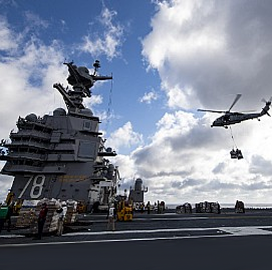
Sailors onboard the USS Gerald R. Ford wrapped up a vertical replenishment effort that involved Sikorsky-built helicopters and the USNS Joshua Humphreys tanker as part of the aircraft carrier’s post-delivery test and trials.
The U.S. Navy said Thursday MH-60S Sea Hawk units were attached to Helicopter Sea Combat Squadron 9’s “tridents” to deliver supplies to Ford in the Atlantic Ocean.
“Exercising and proving our ability to conduct simultaneous fueling and replenishment-at-sea increases the ship’s flexibility to respond to mission requirements as it minimizes our required time alongside a supply ship,” said Cmdr. Carl Koch, supply officer for the CVN 78 vessel.
The PDT&T phase lasts for 18 months and seeks to operational readiness of a ship prior to mission deployment.
Commander Naval Air Forces Atlantic inspectors certified Ford’s flight deck and air traffic control station last week.





